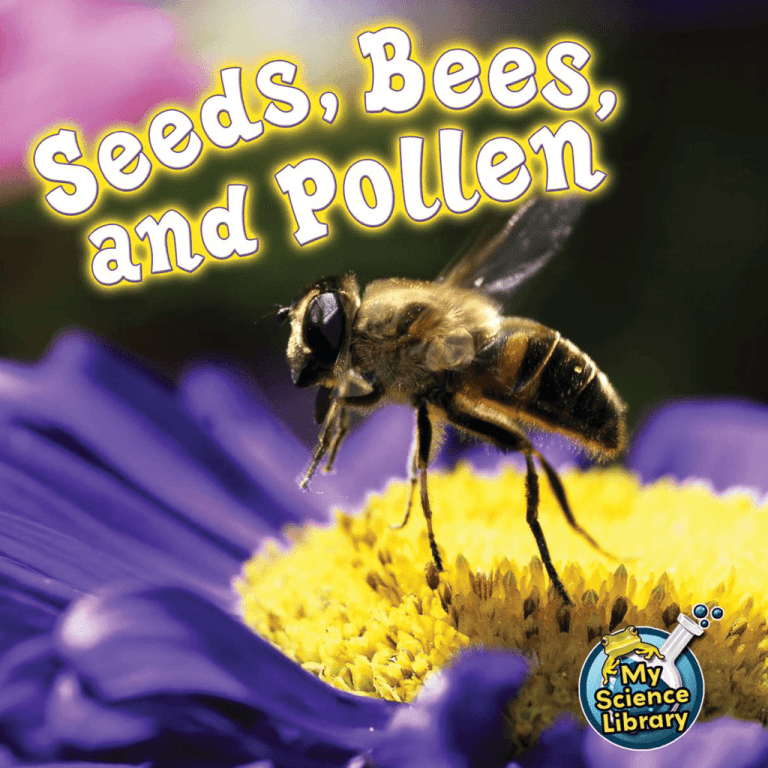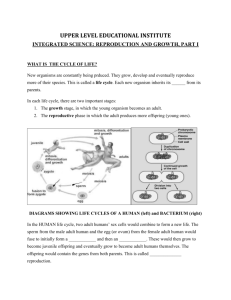
ocus:
gF
Teachin
Suffixes
:
y
r
la
u
b
Voca
he word
he
Look at t
What is t
?
s
s
e
rl
e
flow
ow does
H
?
d
r
o
w
root
nge the
a
h
c
x
fi
f
?
the su
he word
t
f
o
g
in
mean
Level: L
Word Count: 184
100th Word: spores (page 12)
Tips on Reading This
Book with Children:
1. Read the title.
Predictions – after reading the title have children
make predictions about the book.
2. Take a book walk.
Talk about the pictures in the book. Use the content words from the book as you take the picture walk.
Have children find one or two words they know as they do a picture walk.
3. Have children find words they recognize in the text.
4. Have children read the remaining text aloud.
5. Strategy Talk – use to assist children while reading.
• Get your mouth ready
• Look at the picture
• Think…does it make sense
• Think…does it look right
• Think…does it sound right
• Chunk it – by looking for a part you know
2-3
My
c
S ience
Library
s
l
L eve
6. Read it again.
7. Complete the activities at the end of the book.
Seeds, Bees, and Pollen
by Julie K. Lundgren
Science Content Editor:
Kristi Lew
www.rourkeclassroom.com
Science content editor: Kristi Lew
A former high school teacher with a background in biochemistry and more than 10 years of experience in cytogenetic laboratories, Kristi Lew specializes in taking complex scientific information and making it fun and interesting for
scientists and non-scientists alike. She is the author of more than 20 science books for children and teachers.
© 2012 Rourke Publishing LLC
All rights reserved. No part of this book may be reproduced or utilized in any form or by any means, electronic or mechanical including photocopying, recording, or by any information storage and retrieval system without permission in writing from
the publisher.
www.rourkeclassroom.com
Photo credits: Cover © Christian Musat, Cover logo frog © Eric Pohl, test tube © Sergey Lazarev; Table of Contents ©
Garsya; Page 4 © alexcoolok; Page 5 © pzAxe, oksix; Page 7 © Matthijs Wetterauw; Page 9 © Alyssia Sheikh; Page 10
© irin-k; Page 11 © Eduardo Ramirez Sanchez; Page 12 © Stargazer; Page 13 © Alex James Bramwell; Page 14 © AGorohov; Page 15 © Lincoln Rogers; Page 16 © Anest, Dr U; Page 17 © Studio Barcelona; Page 18 © dabjola; Page 19 ©
Aleksander Bolbot; Page 20 © Studio Barcelona, Chrislofoto; Page 21 © dabjola, Alex James Bramwell
Editor: Kelli Hicks
Cover and page design by Nicola Stratford, bdpublishing.com
Library of Congress Cataloging-in-Publication Data
Lundgren, Julie K.
Seeds, bees, and pollen / Julie K. Lundgren.
p. cm. -- (My science library)
Includes bibliographical references and index.
ISBN 978-1-61741-748-1 (Hard cover) (alk. paper)
ISBN 978-1-61741-950-8 (Soft cover)
1. Pollination--Juvenile literature. 2. Honeybee--Juvenile literature. 3. Conifers--Juvenile literature. I. Title.
QK926.L96 2012
571.8’642--dc22
2011004761
Rourke Publishing
Printed in China,
Power Printing Company Ltd
Guangdong Province
042011
042011LP
www.rourkeclassroom.com - rourke@rourkepublishing.com
Post Office Box 643328 Vero Beach, Florida 32964
Table of Contents
Plants Make More Plants 4
Flowering Plants
6
Plants Without Flowers 12
Show What You Know 22
Glossary23
Index24
Plants Make More Plants
All living things reproduce, including
plants. Different types of plants reproduce
in different ways.
Some
kinds
fruit
in or of plants
der t
o rep make
rodu
ce.
4
Do y
ou
these know h
ow e
plant
ac
s rep
rodu h of
ces?
5
Flowering Plants
Many plants use flowers
to reproduce. Flowers make
pollen and seeds. Flowers
must trade their pollen with
other flowers to make seeds.
6
Polle
n
dust looks lik
e gol
on b
utter
d
flies. en
pollen
7
Flower pollen travels on the wind or on
animals. Butterflies, birds, bees, bats, and
other pollinators sip sweet flower nectar. As they feed, pollen sticks to their bodies
and brushes off on the next flower. Now
that the flower has pollen from another
flower, it can begin making seeds.
8
pollen
9
BEE FOOD
Bees also eat pollen. Honeybees and
bumblebees have special pouches on
their back legs for carrying pollen back
to the hive. Plants have enough pollen
for reproduction and for bees.
10
pollen
11
Plants Without Flowers
Flowerless plants reproduce in
other ways. Mosses and ferns
make spores. Spores make
new plants without using pollen
or flowers.
12
Ferns
m
the b ake spo
re
u
their mps on t s inside
he ba
leave
ck of
s.
13
Conifers make seeds inside cones. Cones
need pollen to make seeds. Only wind
carries conifer pollen to new trees.
14
The c
o
gravi nes must
ty or
b
wind e open f
seed
o
s to n
t
ew p o carry th r
laces
e
to gr
ow.
15
Some plants reproduce by copying
themselves. Strawberry plants have runners
that grow out from the main plant and
sprout new plants.
main
plant
16
runner
Runn
e
One rs grow a
bo
st
grow rawberry ve groun
pl
d.
many
runn ant can
ers.
new plants
Straw
berry
too.
They plants flo
wer,
c
runn
ers o an grow
from
r see
ds.
17
Underground stems called rhizomes can
sprout new plants. Rhizomes and runners
make plants exactly like the mother plant.
rhizome
18
Man
y
repro kinds of g
duce
r
from asses
rhizo
mes.
19
Whether they use flowers, cones,
special stems, or spores, plants find ways
to reproduce.
20
flowers
cones
rhizome
spores
21
1. Why are pollinators important to
flowering plants?
2. How do flowerless plants reproduce?
3. Strawberry plants reproduce two
22
ways. Can you think of other plants
that use more than one way
to reproduce?
Glossary
conifers (KON-uh-ferz): trees that make cones, including pines,
spruce, and other evergreens
nectar (NECK-ter): sweet liquid inside flowers that bees and other animals use for food
pollen (POL-in): tiny grains made by seed plants and transported
by wind or animals to a new plant for the purpose of
making seeds
pollinators (POL-uh-nay-terz): animals that carry pollen from flower to flower
reproduce (ree-pruh-DOOSS): make more of itself
rhizomes (RYE-zohmz): thick, underground horizontal stems that produce roots and have shoots that develop into
new plants
runners (RUN-erz): thin, above ground stems that grow out from
the main plant and put down roots to form new plants
spores (SPORZ): tiny, powdery grains made by ferns and mosses in order to grow new plants without seed-making
23
Index
bees 8
flower(s) 6, 8, 12, 17, 20
pollen 6, 7, 8, 10, 12, 14
pollinators 8
rhizomes 18, 19
runners 16, 17, 18
seed(s) 6, 14, 17
spores 12, 13, 20, 21
wind 8, 14
Websites
www2.bgfl.org/bgfl2/custom/resources_ftp/client_ftp/ks2/science/
plants_pt2/parts.htm
www.backyardnature.net/conifers.htm
www.biology4kids.com/files/plants_reproduction.html
www.fws.gov/pollinators/
About the Author
As a child, Julie K. Lundgren lived
near Lake Superior where she once
grew a giant turnip and had many
pets. Her interest in plants and
animals led her to a degree in
biology. She lives in Minnesota
with her family.
24
Comprehension & Extension:
Sight Words I Used:
•Summarize:
make
other
they
use
What are some of the different ways plants
can reproduce?
How is pollen important to the process?
•
Text to Self Connection:
Have you ever watched bees move from one
flower to the next?
Have you ever been stung by a bee?
•Extension: Five Facts!
Write 5 facts that you learned from reading
this book.
Write them in complete sentences.
2-3
My
c
S ience
Library
l
L eve
s
Vocabulary Check:
Use glossary words in a
sentence.
Have you ever wondered about the science all around us? Plants
grow and change, the Sun rises to warm the Earth, and matter
changes from one form to another. Investigate Life, Physical, Earth,
and Technology science topics with Rourke’s My Science Library. This
library explores NSTA science standards with engaging text and
colorful images to support readers from kindergarten to third grade.
Are you ready to investigate?
Books in My Science Library:
Earth is Tilting!
Gravity! Do You Feel It?
Let’s Classify Animals!
Melting Matter
Natural or Man-Made?
Plants Make Their Own Food
Seeds, Bees, and Pollen
Studying Weather and Climates
What Do Critters Do in the Winter?
What’s on the Food Chain Menu?
Where Did the Water Go?
Zap! It’s Electricity!
www.rourkeclassroom.com
Printed in China








